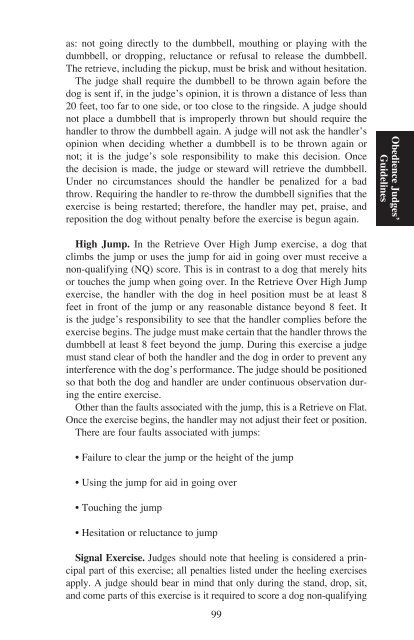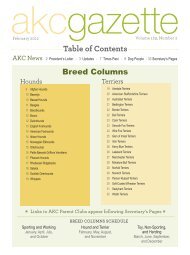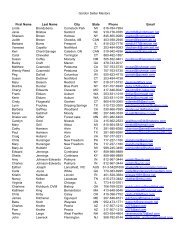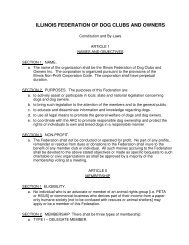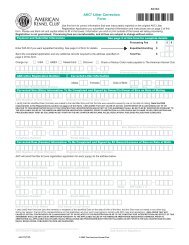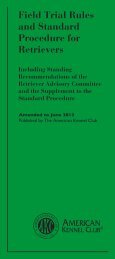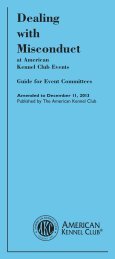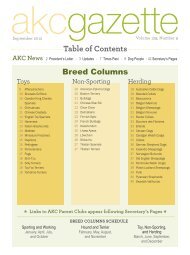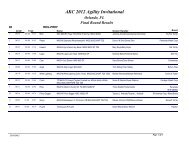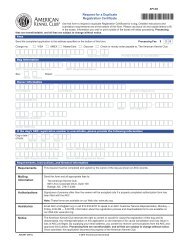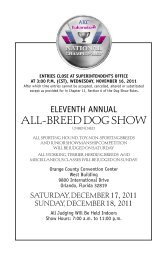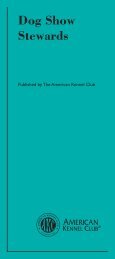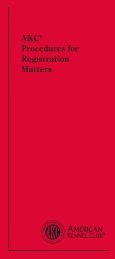Obedience Regulations - American Kennel Club
Obedience Regulations - American Kennel Club
Obedience Regulations - American Kennel Club
Create successful ePaper yourself
Turn your PDF publications into a flip-book with our unique Google optimized e-Paper software.
as: not going directly to the dumbbell, mouthing or playing with the<br />
dumbbell, or dropping, reluctance or refusal to release the dumbbell.<br />
the retrieve, including the pickup, must be brisk and without hesitation.<br />
the judge shall require the dumbbell to be thrown again before the<br />
dog is sent if, in the judge’s opinion, it is thrown a distance of less than<br />
20 feet, too far to one side, or too close to the ringside. A judge should<br />
not place a dumbbell that is improperly thrown but should require the<br />
handler to throw the dumbbell again. A judge will not ask the handler’s<br />
opinion when deciding whether a dumbbell is to be thrown again or<br />
not; it is the judge’s sole responsibility to make this decision. once<br />
the decision is made, the judge or steward will retrieve the dumbbell.<br />
under no circumstances should the handler be penalized for a bad<br />
throw. requiring the handler to re-throw the dumbbell signifies that the<br />
exercise is being restarted; therefore, the handler may pet, praise, and<br />
reposition the dog without penalty before the exercise is begun again.<br />
High Jump. in the retrieve over High Jump exercise, a dog that<br />
climbs the jump or uses the jump for aid in going over must receive a<br />
non-qualifying (nQ) score. this is in contrast to a dog that merely hits<br />
or touches the jump when going over. in the retrieve over High Jump<br />
exercise, the handler with the dog in heel position must be at least 8<br />
feet in front of the jump or any reasonable distance beyond 8 feet. it<br />
is the judge’s responsibility to see that the handler complies before the<br />
exercise begins. the judge must make certain that the handler throws the<br />
dumbbell at least 8 feet beyond the jump. During this exercise a judge<br />
must stand clear of both the handler and the dog in order to prevent any<br />
interference with the dog’s performance. the judge should be positioned<br />
so that both the dog and handler are under continuous observation during<br />
the entire exercise.<br />
other than the faults associated with the jump, this is a retrieve on Flat.<br />
once the exercise begins, the handler may not adjust their feet or position.<br />
there are four faults associated with jumps:<br />
• Failure to clear the jump or the height of the jump<br />
• Using the jump for aid in going over<br />
• Touching the jump<br />
• Hesitation or reluctance to jump<br />
Signal Exercise. Judges should note that heeling is considered a principal<br />
part of this exercise; all penalties listed under the heeling exercises<br />
apply. A judge should bear in mind that only during the stand, drop, sit,<br />
and come parts of this exercise is it required to score a dog non-qualifying<br />
99<br />
<strong>Obedience</strong> Judges’<br />
Guidelines


